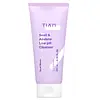What's inside
What's inside
 Key Ingredients
Key Ingredients

 Benefits
Benefits

 Concerns
Concerns

 Ingredients Side-by-side
Ingredients Side-by-side

Water
Skin ConditioningCocamidopropyl Betaine
CleansingSodium Lauroyl Methyl Isethionate
CleansingSnail Secretion Filtrate
Skin ConditioningPolysorbate 60
EmulsifyingButylene Glycol
Humectant1,2-Hexanediol
Skin ConditioningAcrylates Copolymer
Tromethamine
BufferingEthyl Hexanediol
SolventSodium Polyacrylate
AbsorbentChamomilla Recutita Flower Oil
MaskingDipropylene Glycol
HumectantPanthenol
Skin ConditioningAllantoin
Skin ConditioningCitric Acid
BufferingPhenoxyethanol
PreservativeSodium Chloride
MaskingSodium Guaiazulene Sulfonate
Water, Cocamidopropyl Betaine, Sodium Lauroyl Methyl Isethionate, Snail Secretion Filtrate, Polysorbate 60, Butylene Glycol, 1,2-Hexanediol, Acrylates Copolymer, Tromethamine, Ethyl Hexanediol, Sodium Polyacrylate, Chamomilla Recutita Flower Oil, Dipropylene Glycol, Panthenol, Allantoin, Citric Acid, Phenoxyethanol, Sodium Chloride, Sodium Guaiazulene Sulfonate
Centella Asiatica Extract 50.47%
CleansingWater
Skin ConditioningPropanediol
Solvent1,2-Hexanediol
Skin ConditioningGlycerin
HumectantHydroxyacetophenone
AntioxidantBetaine
HumectantMineral Salts
Skin ConditioningPanthenol
Skin ConditioningEthylhexylglycerin
Skin ConditioningSodium Polyacryloyldimethyl Taurate
Emulsion StabilisingDisodium EDTA
Butylene Glycol
HumectantSalix Alba Bark Extract
AstringentCastanea Crenata Shell Extract
Skin ConditioningLavandula Angustifolia Flower Extract
CleansingHyaluronic Acid
HumectantHydrolyzed Hyaluronic Acid
HumectantSodium Hyaluronate
HumectantAllantoin
Skin ConditioningCitric Acid
BufferingCapryloyl Salicylic Acid
ExfoliatingGluconolactone
Skin ConditioningSodium Citrate
BufferingSalicylic Acid
MaskingGlycolic Acid
BufferingCentella Asiatica Extract 50.47%, Water, Propanediol, 1,2-Hexanediol, Glycerin, Hydroxyacetophenone, Betaine, Mineral Salts, Panthenol, Ethylhexylglycerin, Sodium Polyacryloyldimethyl Taurate, Disodium EDTA, Butylene Glycol, Salix Alba Bark Extract, Castanea Crenata Shell Extract, Lavandula Angustifolia Flower Extract, Hyaluronic Acid, Hydrolyzed Hyaluronic Acid, Sodium Hyaluronate, Allantoin, Citric Acid, Capryloyl Salicylic Acid, Gluconolactone, Sodium Citrate, Salicylic Acid, Glycolic Acid
 Reviews
Reviews

Ingredients Explained
These ingredients are found in both products.
Ingredients higher up in an ingredient list are typically present in a larger amount.
1,2-Hexanediol is a synthetic liquid and another multi-functional powerhouse.
It is a:
- Humectant, drawing moisture into the skin
- Emollient, helping to soften skin
- Solvent, dispersing and stabilizing formulas
- Preservative booster, enhancing the antimicrobial activity of other preservatives
Allantoin is a soothing ingredient known for its protective and moisturizingg properties. Because of this, it is often added to products with strong active ingredients.
Studies show higher concentrations of this ingredient can promote wound healing.
Though it can be derived from the comfrey plant, allantoin is produced synthetically for cosmetic products to ensure purity.
Learn more about AllantoinButylene Glycol (or BG) is used within cosmetic products for a few different reasons:
Overall, Butylene Glycol is a safe and well-rounded ingredient that works well with other ingredients.
Though this ingredient works well with most skin types, some people with sensitive skin may experience a reaction such as allergic rashes, closed comedones, or itchiness.
Learn more about Butylene GlycolCitric Acid is an alpha hydroxy acid (AHA) naturally found in citrus fruits like oranges, lemons, and limes.
Like other AHAs, citric acid can exfoliate skin by breaking down the bonds that hold dead skin cells together. This helps reveal smoother and brighter skin underneath.
However, this exfoliating effect only happens at high concentrations (20%) which can be hard to find in cosmetic products.
Due to this, citric acid is usually included in small amounts as a pH adjuster. This helps keep products slightly more acidic and compatible with skin's natural pH.
In skincare formulas, citric acid can:
While it can provide some skin benefits, research shows lactic acid and glycolic acid are generally more effective and less irritating exfoliants.
Most citric acid used in skincare today is made by fermenting sugars (usually from molasses). This synthetic version is identical to the natural citrus form but easier to stabilize and use in formulations.
Read more about some other popular AHA's here:
Learn more about Citric AcidPanthenol is a common ingredient that helps hydrate and soothe the skin. It is found naturally in our skin and hair.
There are two forms of panthenol: D and L.
D-panthenol is also known as dexpanthenol. Most cosmetics use dexpanthenol or a mixture of D and L-panthenol.
Panthenol is famous due to its ability to go deeper into the skin's layers. Using this ingredient has numerous pros (and no cons):
Like hyaluronic acid, panthenol is a humectant. Humectants are able to bind and hold large amounts of water to keep skin hydrated.
This ingredient works well for wound healing. It works by increasing tissue in the wound and helps close open wounds.
Once oxidized, panthenol converts to pantothenic acid. Panthothenic acid is found in all living cells.
This ingredient is also referred to as pro-vitamin B5.
Learn more about PanthenolWater. It's the most common cosmetic ingredient of all. You'll usually see it at the top of ingredient lists, meaning that it makes up the largest part of the product.
So why is it so popular? Water most often acts as a solvent - this means that it helps dissolve other ingredients into the formulation.
You'll also recognize water as that liquid we all need to stay alive. If you see this, drink a glass of water. Stay hydrated!
Learn more about Water